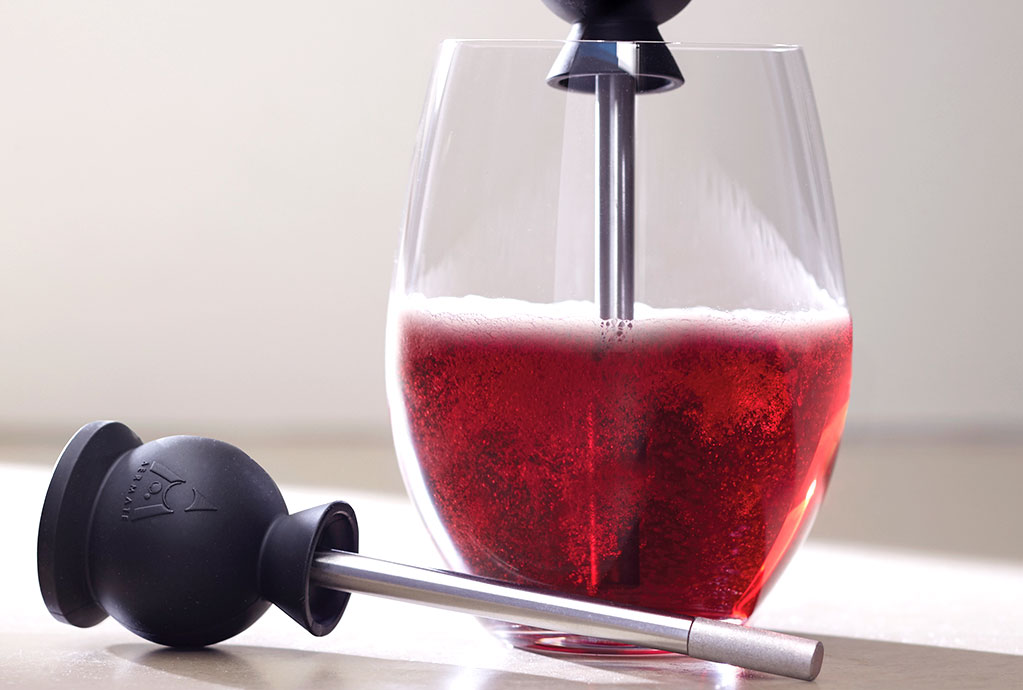
Many wines can benefit from a little sprucing up before they’re poured into glasses and made vulnerable to the ooOs and Boos of public opinion. Ultra-premium wines can fall magnificently flat if care isn’t taken during the final details of service, and a rustic wine plucked from the shelves of a local supermarket can hit some unexpected high notes with a little bit of prep backstage.
Whether you’re popping a questionable bottle gifted by a dinner guest or have pulled one of your favorites from your cellar, sprucing up the experience in the final moments before tasting requires a bit of knowledge, creativity and gumption.
Here are some tips and tricks to spiff up any glass of wine.

Go-go gadget aerator
Wine aerators are quickly becoming popular wine accessories. These hand-held contraptions provide the same benefits of a traditional decanter, minus the lag time.
In a pinch, when decanting would simply take too long, pouring wine through an aerator can relax the wine and open up the aromas in just a matter of seconds.

Repurpose the coffee filter
There’s no worse wine catastrophe than wrenching up a corkscrew only to realize the cork disintegrated on contact, leaving behind a slew of floaty bits in the bottle. If that happens, don’t panic, just pour the bottle through a coffee filter and into a decanter.
If you do it quickly in the kitchen before bringing the wine out to your guests, no-one will be the wiser that you neared the brink of disaster.
Chill the reds
We all know that bubblies, whites and rosés benefit from being chilled before serving, but what about the red wines of the world?
Make room for a bottle of red wine in the refrigerator. Unless you have a wine fridge or cellar, it’s best to lightly chill red wine just before service. That means between 53° and 63° Fahrenheit for light-bodied reds, and 64-70°F for full-bodied reds. The bottle should feel slightly cool to the touch. If you aren’t sure what temperature to serve it at, consider purchasing a wraparound wine bottle thermometer.
Frozen grapes
How exactly do you drop a wine’s temperature in a pinch? Keep a handful of frozen grapes in your freezer to use as an ice cube substitute. Using traditional ice cubes in your glass will quickly drop the temperature, but will dilute the experience in the process, leaving watery wine in the bottom of your glass.
Grapes – whether red or white – won’t affect the wine’s flavor and prevent a watery mess, not to mention everyone will enjoy a tasty treat when the wine runs dry. This emergency tactic is best reserved for average wine, not the top-shelf variety.

Add a pinch of salt
Quickly bring your wine down to the proper serving temperature in an ice bucket (never put it in the freezer).
Fill the bucket with water and stir in 1/8 cup of salt, then position the bottle right in the middle. The salt will bring the water down to a lower temperature, chilling the bottle faster. In five to ten minutes, your bottle will be ready to serve.
Don’t break the seal
Occasions that call for a glass or two of wine – rather than a trip to the bottom of the bottle – can benefit by the use of a Coravin. The Coravin is the newest gizmo on the wine scene, and allows you to extract wine from the bottle without removing the cork and without tainting the wine that remains behind. That means no more leftover wine going to waste, and every glass tastes as good as the first.

Bring out the glassware
Finally, pay credence to the importance of serving your wine in a quality wine glass.
Choose glassware appropriate to the wine type. Red wines generally are served in a glass with a larger bowl, sparkling wines in a flute that exposes little surface area, and whites in a smaller glass with a narrow opening. The shape of the glass affects how the aromas are concentrated, how the wine is distributed across the palate and how savvy the wine host or hostess is perceived. There’s a reason wine is rarely sipped from a regular cup.
Whether the wine requires a full-blown makeover, or simply needs a slight temperature adjustment, the final details before service can make all the difference. After all, even the finest among us require a sprucing up from time to time.
What other wine tips do you have to make each glass taste its best?
About the author: Madeline Blasberg is a Certified Wine Consultant currently working as the Official Wine Commentator & Reviewer for Etching Expressions. She has spent time living in Mendoza, Argentina where she was surrounded by wine, both personally and professionally.